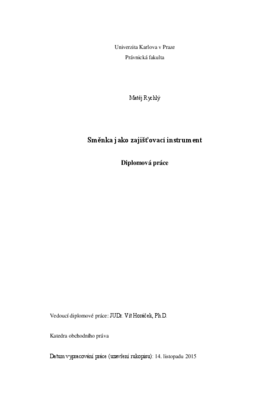Směnka jako zajišťovací instrument
Bill of exchange as a securing instrument
diplomová práce (OBHÁJENO)

Zobrazit/
Trvalý odkaz
http://hdl.handle.net/20.500.11956/75994Identifikátory
SIS: 143448
Katalog UK: 990020725470106986
Kolekce
- Kvalifikační práce [14715]
Autor
Vedoucí práce
Oponent práce
Zahradníčková, Marie
Fakulta / součást
Právnická fakulta
Obor
Právo
Katedra / ústav / klinika
Katedra obchodního práva
Datum obhajoby
12. 1. 2016
Nakladatel
Univerzita Karlova, Právnická fakultaJazyk
Čeština
Známka
Výborně
Klíčová slova (česky)
ručení, směnka, zajišťovací instrument, zajišťovací směnka, zástavní právoKlíčová slova (anglicky)
suretyship, bill of exchange, securing instrument, securing bill of exchange, pledgeResumé Směnka byla historicky využívána k platebním účelům. V průběhu času se ale přišlo na to, že může plnit i specifickou funkci zajišťovacího instrumentu. Takovéto využití směnky ale s sebou přináší řadu teoretických i praktických nejasností. Proto je jedním z hlavních cílů této diplomové práce analyzovat zajišťovací směnku a rozebrat a popsat její jednotlivé atributy a specifika, která se k ní vážou. Dalším hlavním cílem práce je srovnání zajišťovací směnky s jinými zajišťovacími prostředky, které občanské právo nabízí, konkrétně se jedná o zástavní právo a ručení. Díky tomuto srovnání lze lépe ukázat, zda je směnka vhodným zajišťovacím prostředkem, a jaké jsou její silné a slabé stránky. Jako metoda práce je užita analýza a srovnání. Práce je rozdělena celkem do devíti kapitol. V první kapitole jsou uvedeny cíle a směr, jakým se bude tato práce ubírat, a dále nastíněn obsah jednotlivých kapitol. Druhá kapitola se zabývá obecným vymezením směnky, uvádí druhy směnek, které existují. Dále vymezuje možné funkce směnky, přičemž těmito funkcemi jsou funkce platidla, platebního nástroje nebo zajišťovacího instrumentu. Ve třetí kapitole je popsána podstata zajišťovací směnky, která je hlavně definována střetem abstraktnosti a samostatnosti s akcesoritou a subsidiaritou. Dále je vymezena smlouva o zajištění...
A bill of exchange was historically used for payment purposes. However, over time it was figured out that it can designate as a securing instrument. Such a usage of a bill of exchange brings as well a series of theoretical and practical confusions. Therefore, one of the main aims of this thesis is to analyze a securing bill of exchange and examine and describe the different attributes and specifics that bind to it. Another main aim of this thesis is securing bill of exchange to be compared with another hedging instruments which are provided by civil law, such as the pledge and the suretyship. Because of this comparison it is easier to show if the bill of exchange is an appropriate securing instrument, and what are its strengths and weaknesses. As a working method is using analysis and comparison. The thesis is divided into nine chapters. The first chapter sets out the aims and the direction which the thesis will take and further outline of the content of each chapter. The second chapter deals with the general definition of a bill of exchange, lists the types of a bill of exchange that exist. It also defines the functions of a bill of exchange, where these functions are meant a tender, payment tool or securing instrument. The third chapter describes the essence of a securing bill of exchange, which...
